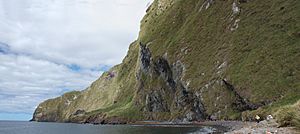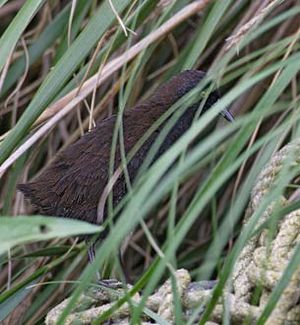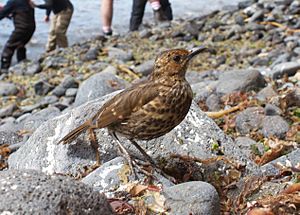Inaccessible Island rail facts for kids
Quick facts for kids Inaccessible Island rail |
|
|---|---|
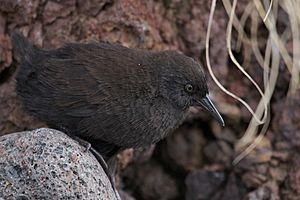 |
|
| Conservation status | |
| Scientific classification | |
| Genus: |
Laterallus
|
| Species: |
rogersi
|
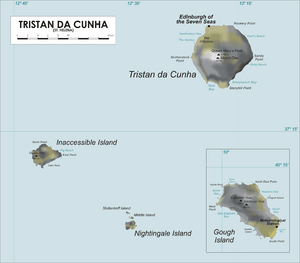 |
|
| Inaccessible Island in the Tristan Archipelago | |
| Synonyms | |
|
|
The Inaccessible Island rail (Laterallus rogersi) is a tiny bird. It belongs to the rail family, called Rallidae. This bird lives only on Inaccessible Island. This island is part of the Tristan Archipelago in the South Atlantic Ocean. It is the smallest flightless bird in the world that is still alive today.
A doctor named Percy Lowe officially described this species in 1923. However, scientists first noticed it about 50 years earlier. For a long time, no one knew exactly which birds were its closest relatives. In 2018, scientists used DNA to find out. They discovered its closest relative is the dot-winged crake from South America. Because of this, they suggested putting both species in the same group, Laterallus.
The Inaccessible Island rail is a small bird with brown feathers. It has a black beak and black feet. Adult birds have bright red eyes. These rails live in almost all parts of Inaccessible Island. You can find them from the beaches up to the high central plateau. They eat many small bugs and some plants. Pairs of rails stay together and defend their own area. Both parents help to hatch the eggs and raise their young. This bird has special ways of living on a small island. These include a low energy use, laying few eggs, and not being able to fly.
Unlike many other islands, Inaccessible Island has no introduced animals that hunt. This has helped the rail to survive and thrive. Many other flightless birds, especially rails, have disappeared because of new predators. Even so, the Inaccessible Island rail is considered vulnerable. This is because it lives in only one small place. If animals like rats or cats accidentally arrived, they could threaten the rails.
Contents
Discovery of the Inaccessible Island Rail
The people of Tristan da Cunha might have known about this bird already. They visited Inaccessible Island every year to hunt seals. However, scientists first learned about the rail during the Challenger expedition. This expedition explored the world from 1872 to 1876. When they visited the island in October 1873, Sir Charles Wyville Thomson heard about the bird. He learned about it from two German brothers, the Stoltenhoffs. They had been living on the island for two years. Thomson was sad that he could not collect a bird specimen.
Later, other people tried to get a specimen. Lord Crawford tried in 1905 on his yacht Valhalla. Another attempt was made during the Shackleton–Rowett Expedition in April 1922. They also failed to get a bird. But they left collecting tools with Rev. H. M. C. Rogers. He was a chaplain on Tristan da Cunha. The next year, two bird skins arrived at the Natural History Museum, London. Soon after, another skin and a bird preserved in liquid arrived.
With these specimens, Dr. Percy Lowe could finally describe the species. He did this briefly at a meeting in 1923.
Evolution and Family Tree
Before the bird was collected, scientists thought it was like other "island hens." But after studying it, Lowe felt it was so unique it needed a "new genus." He named this new group Atlantisia. This name comes from the mythical island of Atlantis. The species name rogersi honors Rev. Rogers. He was the one who collected the first birds for Lowe.
In 1928, Lowe thought the Inaccessible Island rail came from flightless birds. He believed they reached the island by a land bridge. This was a common idea before we understood plate tectonics. By 1955, scientists knew the rail's ancestors must have flown to the island. They also guessed that, like most birds on the Tristan Archipelago, it came from South America.
Figuring out where the Inaccessible Island rail fits in the rail family was hard. Lowe thought it might be related to the black crake from Africa. This was based on how their feathers looked. But he admitted it was difficult to be sure. In 1973, a scientist named Storrs Olson suggested it was related to the Rallus group. This idea was based on its bones.
The most recent study in 1998 placed it near the Laterallus group. This group includes small crakes mostly found in South America.
Two other extinct flightless rails were once thought to be in the same group as the Inaccessible Island rail. These were the Ascension crake and the Saint Helena swamphen. But today, scientists believe they evolved separately. The Inaccessible Island rail is now the only species in its original group, Atlantisia. Both the Ascension crake and Saint Helena swamphen disappeared. This happened because of predation by introduced species like cats and rats.
In 2018, a study used DNA to solve the mystery. They found that the Inaccessible Island rail is closely related to the dot-winged crake. It is also related to the black rail and likely the Galapagos crake. Because of this, scientists suggested putting the Inaccessible Island rail into the Laterallus group. They believe it flew to Inaccessible Island from South America about 1.5 million years ago.
Appearance and Body Features
The Inaccessible Island rail is the smallest living flightless bird. It measures about 13 to 15.5 centimeters (5 to 6 inches) long. Males are a bit bigger and heavier than females. Males weigh around 35 to 49 grams (1.2 to 1.7 ounces). Females weigh about 34 to 42 grams (1.2 to 1.5 ounces).
The bird is dark chestnut-brown on its back. Its head and belly are dark grey. It has faded white stripes on its sides and belly. Adult birds have red eyes. Females look similar to males but have lighter grey and a slight brown tint underneath. It has a black bill that is shorter than its head.
The feathers of this rail are almost like hair. Its flight feathers are not strong. The tiny hooks on many feathers do not connect well. This makes the feathers look messy. Its wings are small and weak. They are smaller than those of flying birds of the same size. The breastbone is also small. Its tail is short, about 3.5 cm (1.4 inches) long.
The Inaccessible Island rail has a low basal metabolic rate (BMR). This means it uses less energy than expected for a bird its size. Scientists think this low energy use is because of its island life. The island has no predators or other birds competing for food. This means the rails can save energy. This leads to their small size, low BMR, and inability to fly.
Where They Live and Their Home
The Inaccessible Island rail lives only on the uninhabited Inaccessible Island. This island is part of the Tristan da Cunha group. The island is about 14 square kilometers (5.4 square miles) in size. It has a cool, wet oceanic climate. This means lots of rain, little sunshine, and strong winds.
The rail lives in almost every part of the island. You can find it from sea-level up to 449 meters (1,473 feet) high. It is most common in fields of tall tussock grass. Here, you can find about 10 birds per hectare (2.5 acres). In areas with tussock grass mixed with ferns, there are even more, about 15 birds per hectare. This habitat is found near the shore and covers most of the island's steep cliffs.
The rail also lives in upland areas with ferns and bushes. It can be found in the island forest on the central plateau. This forest has wind-bent tree-ferns and Island Cape myrtle trees. In these areas, there are about two birds per hectare. They also look for food among rocks on the beaches. They use natural holes among rocks or tunnels in the grass to move around secretly.
Behavior and Daily Life
The Inaccessible Island rail is very territorial. This means they defend their own small areas. In the tussock grass areas, where many rails live, their territories are tiny. They are only about 0.01 to 0.04 hectares (0.02 to 0.1 acres). Because their areas are so small, families and individual birds often meet. This leads to frequent arguments and loud calls.
When two birds meet, they start with loud trills or chirps. Then, they might face each other very closely. They display by lowering their heads and pointing their beaks to the ground. They might circle each other. This continues until one bird slowly backs away. Sometimes, a quick fight happens, and one bird is chased off.
What They Eat and How They Find Food
The Inaccessible Island rail searches for food slowly and carefully. Their way of foraging has been compared to a mouse. They eat many different small creatures. These include earthworms, small crustaceans, mites, and various insects. They eat beetles, flies, moths, and caterpillars. Centipedes are also a part of their diet. They also eat berries from Empetrum and Nertera plants. They also eat seeds from the dock plant Rumex. Unlike the Tristan thrush, they do not eat dead animals or fish.
Calls and Sounds
The Inaccessible Island rail is a very noisy bird. It calls often. This might be because they live in thick plants, so calls are the best way to talk. Pairs and families often make contact calls while they are eating.
They use a long trill when pairs meet or when facing a rival. Rivals also make a long chirping sound, "keekeekeekeekee." This can be long or short and end with a "keekeechitrrrr." After fights, the winning bird might make a "weechup weechup" call. Birds might make a quiet "tchik tchik tchok tchik" sound while hunting. The alarm call, when predators are near, is a short, sharp "chip." They also make different trilling calls while sitting on eggs. This happens especially when partners switch places during incubation.
Reproduction and Life Cycle
The Inaccessible Island rail breeds at certain times of the year. They lay eggs between October and January. They are monogamous, meaning they stay with one partner for life. Their nests are built at the bottom of ferns or in clumps of tussock grass.
The nests are shaped like a dome, oval or pear-shaped. The entrance is near the narrow end of the nest. A small path or tunnel leads up to half a meter away from the entrance. Nests are usually made entirely of the plant material they are found in. For example, if in tussock grass, the nest is made of tussock grass. Larger leaves are used on the outside, and finer material lines the inside. Sometimes, other materials are used for lining, like leaves from apple or willow trees.
They lay two eggs at a time. This is a small number for such tiny rails. The eggs are greyish-white with brown-red spots. They also have lavender-purple spots, mostly at the wider end. The eggs are large for the size of the mother bird. They look similar to the eggs of the corn crake.
We don't know exactly how long the eggs take to hatch. But both parents sit on the eggs. Males seem to incubate for longer. Both parents bring food to their partner who is sitting on the nest. The food is eaten on or near the nest. When they switch places, they make "chip chip chip" calls. These calls get louder if the partner takes a long time to respond.
The eggs hatch within 23 to 32 hours of each other. The chick inside the egg can call for up to 45 hours before hatching. One hatching was seen taking 15 hours to finish. Newly hatched chicks are covered in soft black feathers. Their legs, feet, and beak are black. Their mouth is shiny silver.
Ecology and Other Animals
In 1927, Lowe thought the brown skua was the only animal that hunted the Inaccessible Island rail. This was because there were no mammals on the island. A study of brown skua diets confirmed this. However, rails and other landbirds were only a small part of the skua's diet. This was true even though there were many rails on the island. Scientists noticed that landbirds made alarm calls when brown skuas were seen.
When an adult Inaccessible Island rail hears another rail make an alarm call, it becomes alert. The chicks, however, become silent. Adult rails are rarely hunted. But many chicks die, and being eaten by Tristan thrushes is a main cause of death.
Two types of chewing lice have been found on Inaccessible Island rails. These are Pscudomenopon scopulacorne and Rallicola (Parricola) zumpti. R. zumpti has not been found on any other bird species from Inaccessible Island.
Threats and How We Protect Them
The Inaccessible Island rail lives in a very small area. There is only one population of these birds in the world. Even though there are about 5,600 adult birds, the species is considered vulnerable. This means it is at risk if a new species were to arrive on Inaccessible Island. Island rails, especially flightless ones, are very likely to disappear.
Animals like house mice, wild cats, and brown rats are not on Inaccessible Island. They have never been there. But they are on nearby Tristan da Cunha. They could reach Inaccessible Island on fishing boats or other ships. Because of this risk, the IUCN Red List calls this species vulnerable. Fires in the tussock grass, which happened in 1872 and 1909, likely killed many rails. But there have been no fires since then.
Several things have been done or suggested to protect this bird. Inaccessible Island was once thought of as a place for farming for the Tristan Islanders. This would have destroyed their home and risked bringing in new species. However, the Tristan da Cunha Island Council declared the island a nature reserve in 1994. Now, access to the island is limited. But Tristan Islanders can still visit to collect firewood.
Introduced New Zealand flax has been removed from the island. The island now has a plan to manage its nature. Other ideas to protect this species include teaching the local community more about biosecurity. This means preventing new species from arriving. Another idea is to start a group of rails living in captivity. It has also been suggested to create new groups of rails on other safe islands, like Nightingale Island. This would be a backup if predators reached Inaccessible Island. However, this might harm the native bugs on those islands.
Images for kids
-
Inaccessible Island is part of the Tristan Archipelago.
See also
 In Spanish: Rasconcillo de Tristán de Acuña para niños
In Spanish: Rasconcillo de Tristán de Acuña para niños





